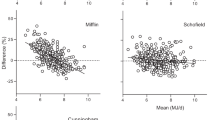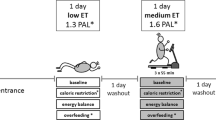Abstract
Objective: To investigate whether or not the lower resting metabolic rate (RMR) in the elderly is entirely due to changes in body composition.
Design: Cross-sectional data of 132 female (age 69.9±5.5 y, body mass index (BMI) 26.5±4.0 kg/m2) and 84 male (age 68.9±5.1 y, BMI 26.1±2.8 kg/m2) participants of the longitudinal study on nutrition and health status in an aging population of Giessen, Germany, as well as that of 159 young women (age 24.8±3.0 y, BMI 21.1±2.5 kg/m2) and 67 young men (age 26.8±3.4 y, BMI 23.3±2.4 kg/m2) were analysed. RMR was measured by indirect calorimetry after an overnight fast and body composition was estimated by bioelectrical impedance analysis and predictive equations from the literature. Analysis of covariance was used to adjust RMR for body composition, body fat distribution and smoking habits. Additionally, RMR that is to be expected theoretically, was calculated on the basis of the subjects' body composition and the specific metabolic rate of the different organs and was compared to measured RMR.
Results: Compared to young subjects adjusted RMR was significantly lower in elderly women (5432±82 vs 5809±70 kJ/day, P<0.01) and men (6971±99 vs 7558±121 kJ/day, P<0.001). In both elderly women and men, measured RMR was markedly lower than calculated RMR (−625±404, −515±570 kJ/day). By contrast, measured and calculated RMR were nearly the same in young men (159±612 kJ/day); in young women the difference between measured and calculated RMR was only −300±457 kJ/day. In both sexes, these differences are significantly larger in the elderly when compared to young adults.
Conclusion: These results support the point of view that the decline in RMR with advancing age cannot be totally due to changes in body composition.
This is a preview of subscription content, access via your institution
Access options
Subscribe to this journal
Receive 12 print issues and online access
$259.00 per year
only $21.58 per issue
Buy this article
- Purchase on Springer Link
- Instant access to full article PDF
Prices may be subject to local taxes which are calculated during checkout

Similar content being viewed by others
References
Arner P (1995): Differences in lipolysis between human subcutaneous and omental adipose tissue. Ann. Med. 27, 435–438.
Baumgartner RN, Stauber PM, McHugh D, Koehler KM & Garry PJ (1995): Cross-sectional age differences in body composition in persons 60+ years of age. J. Gerontol. 50A, M307–M316.
Bosy-Westphal A, Eichhorn C, Kutzner D, Illner K, Heller M & Müller MJ (2003): The age-related decline in resting energy expenditure in humans is due to the loss of fat-free mass and to alterations in its metabolically active components. J. Nutr. 133, 2356–2362.
Conley KE, Jubrias SA & Esselman PC (2000): Oxidative capacity and ageing in human muscle. J. Physiol. 526, 203–210.
Deurenberg P, Van der Kooy K, Leenen R, Weststrate JA & Seidell JC (1991): Sex and age specific prediction formulas for estimating body composition from bioelectrical impedance: a cross-validation study. Int. J. Obes. 15, 17–25.
Elia M (1992): Organ and tissue contribution to metabolic rate. In Energy Metabolism: Tissue Determinants and Cellular Corollaries eds. JM Kinney and HN Tucker, pp 61–79. New York: Raven Press.
Forbes GB (1987): Techniques for estimating body composition. In Human Body Composition: Growth, Aging, Nutrition, and Activity pp 5–100. New York: Springer.
Fukagawa NK, Bandini LG & Young JB (1990): Effect of age on body composition and resting metabolic rate. Am. J. Physiol. 259 (Endocrinol. Metab. 22), E233–E238.
Gallagher D, Belmonte D, Deurenberg P, Wang Z, Krasnow N, Pi-Sunyer FX & Heymsfield SB (1998): Organ-tissue mass measurement allows modeling of REE and metabolically active tissue mass. Am. J. Physiol. 275 (Endocrinol. Metab. 38), E249–E258.
Gallagher D, Allen A, Wang Z, Heymsfield SB & Krasnow N (2000): Smaller organ tissue mass in the ederly fails to explain lower resting metabolic rate. Ann. N. Y. Acad. Sci. 904, 449–455.
Garby L, Lammert O, Kock KF & Thobo-Carlsen B (1993): Weights of brain, heart, liver, kidneys, and spleen in healthy and apparently healthy adult Danish subjects. Am. J. Hum. Biol. 5, 291–296.
Heinsimer JA & Lefkowitz RJ (1986): The impact of aging on adrenergic receptor function: clinical and biochemical aspects. J. Am. Geriatr. Soc. 33, 184–188.
Hoffstedt J, Arner P, Hellers G & Lönnqvist F (1997): Variation in adrenergic regulation of lipolysis between omental and subcutaneous adipocytes from obese and non-obese men. J. Lipid. Res. 38, 795–804.
Hofstetter A, Schutz Y, Jéquier E & Wahren J (1986): Increased 24-hour energy expenditure in cigarette smokers. N. Engl. J. Med. 314, 79–82.
Jones PP, Snitker S, Skinner JS & Ravussin E (1996): Gender differences in muscle sympathetic nerve activity: effect of body fat distribution. Am. J. Physiol. 270 (Endocrinol. Metab. 33), E363–E366.
Keys A, Taylor HL & Grande F (1973): Basal metabolism and age of adult man. Metabolism 22, 579–587.
Kimm SYS, Glynn NW, Aston CE, Poehlman ET & Daniels SR (2001): Effects of race, cigarette smoking, and use of contraceptive medications on resting energy expenditure in young women. Am. J. Epidemiol. 154, 718–724.
Klausen B, Toubro S & Astrup A (1997): Age and sex effects on energy expenditure. Am. J. Clin. Nutr. 65, 895–907.
Krems C, Lührmann PM & Neuhäuser-Berthold M (2004): Physical activity in young and elderly subjects. J. Sports. Med. Phys. Fitness 44, 71–76.
Leenen R, Van der Kooy K, Deurenberg P, Seidell JC, Weststrate JA, Schouten FJM & Hautvast JGAJ (1992): Visceral fat accumulation in obese subjects: relation to energy expenditure and response to weight loss. Am. J. Physiol. 263 (Endocrinol. Metab. 26), E913–E919.
Lührmann PM, Herbert BM & Neuhäuser-Berthold M (2001): Effects of fat mass and body fat distribution on resting metabolic rate in the elderly. Metabolism 50, 972–975.
Moffat RJ & Owens SG (1991): Cessation from cigarette smoking: changes in body weight, body composition, resting metabolism, and energy consumption. Metabolism 40, 465–470.
Nelson KM, Weinsier RL, Long CL & Schutz Y (1992): Prediction of resting energy expenditure from fat-free mass and fat mass. Am. J. Clin. Nutr. 56, 848–856.
Nielsen S, Hensrud DD, Romanski S, Levine JA, Burguera B & Jensen MD (2000): Body composition and resting energy expenditure in humans: role of fat, fat-free mass and extracellular fluid. Int. J. Obes. Relat. Metab. Disord. 24, 1153–1157.
Pannemans DLE & Westerterp KR (1995): Energy expenditure, physical activity and basal metabolic rate of elderly subjects. Br. J. Nutr. 73, 571–581.
Piers LS, Soares MJ, McCormack LM & O'Dea K (1998): Is there evidence for an age-related reduction in metabolic rate? J. Appl. Physiol. 85, 2196–2204.
Poehlman ET & Toth MJ (1995): Mathematical ratios lead to spurious conclusions regarding age- and sex-related differences in resting metabolic rate. Am. J. Clin. Nutr. 61, 482–485.
Poehlman ET, Melby C & Badylak SF (1991): Relation of age and physical exercise status on metabolic rate in younger and older healthy men. J. Gerontol. 46, B54–B58.
Poehlman ET, Goran MI, Gardner AW, Ades PA, Arciero PJ, Katzman-Rooks SM, Montgomery SM, Toth MJ & Sutherland PT (1993a): Determinants of decline in resting metabolic rate in aging females. Am. J. Physiol. 264 (Endocrinol. Metab. 27), E450–E455.
Poehlman ET, Toth MJ & Webb GD (1993b): Sodium–potassium pump activity contributes to the age-related decline in resting metabolic rate. J. Clin. Endocrinol. Metab. 76, 1054–1057.
Ravussin E & Bogardus C (1989): Relationships of genetics, age, and physical fitness to daily energy expenditure and fuel utilization. The relationship between muscle mass and muscle strength in the elderly. Am. J. Clin. Nutr. 49, 968–975.
Reed RL, Pearlmutter L, Yochum K, Meredith KE & Mooradian AD (1991): The relationship between muscle mass and muscle strength in the elderly. J. Am. Geriatr. Soc. 39, 555–561.
Robinson S, Dill DB, Tzankoff SB, Wagner JA & Robinson RD (1975): Longitudinal studies of aging in 37 men. J. Appl. Physiol. 38, 263–267.
Ryan AS, Nicklas BJ & Elahi D (1996): A cross-sectional study on body composition and energy expenditure in women athletes during aging. Am. J. Physiol. 271 (Endocrinol. Metab. 34), E916–E921.
Shock NW, Watkin DM, Yiengst MJ, Norris AH, Gaffney GW, Gregerman RI & Falzone JA (1963): Age differences in the water content of the body as related to basal oxygen consumption in males. J. Gerontol. A. Biol. Sci. Med. Sci. 18, 1–8.
Steen B, Isaksson B & Svanborg A (1979): Body composition at 70 and 75 years of age: a longitudinal population study. J. Clin. Exp. Geront. 1, 185–200.
Suominen H (1997): Changes in physical characteristics and body composition during 5-year follow-up in 75- and 80-year-old men and women. Scand. J. Soc. Med. 53 (Suppl), 19–24.
Svendsen OL, Hassager C & Christiansen C (1993): Impact of regional and total body composition and hormones on resting energy expenditure in overweight postmenopausal women. Metabolism 42, 1588–1591.
Tzankoff SP & Norris AH (1977): Effect of muscle mass decrease on age-related BMR changes. J. Appl. Physiol. 4, 1001–1006.
Tzankoff SP & Norris AH (1978): Longitudinal changes in basal metabolism in man. J. Appl. Physiol. 45, 536–539.
Van Pelt RE, Jones PP, Davy KP, Desouza CA, Tanaka H, Davy BM & Seals DR (1997): Regular exercise and the age-related decline in resting metabolic rate in women. J. Clin. Endocrinol. Metab. 82, 3208–3212.
Vaughan L, Zurlo F & Ravussin E (1991): Aging and energy expenditure. Am. J. Clin. Nutr. 53, 821–825.
Visser M, Deurenberg P, van Staveren WA & Hautvast JGAJ (1995): Resting metabolic rate and diet-induced thermogenesis in young and elderly subjects: relationship with body composition, fat distribution, and physical activity level. Am. J. Clin. Nutr. 61, 772–778.
Warwick PM & Busby R (1993): Prediction of twenty-four-hour energy expenditure in a respiration chamber in smokers and non-smokers. Eur. J. Clin. Nutr. 47, 600–603.
Weir JB de V (1949): New methods for calculating metabolic rate with special reference to protein metabolism. J. Physiol. 109, 1–9.
Weststrate JA, Dekker J, Stoel M, Begheijn L, Deurenberg P & Hautvast JGAJ (1990): Resting energy expenditure in women: impact of obesity and body-fat distribution. Metabolism 39, 11–17.
WHO (World Health Organization) (1985): Energy and protein requirements Report of a Joint FAO/WHO/UNU Expert Consultation. WHO Technical Report Series 724, Geneva.
Withers RT, Smith DA, Tucker RC, Brinkman M & Clark DG (1998): Energy metabolism in sedentary and active 49- to 70-yr-old women. J. Appl. Physiol. 84, 1333–1340.
Author information
Authors and Affiliations
Corresponding author
Additional information
Guarantor: M Neuhäuser-Berthold.
Contributors: CK performed the study with the assistance of all co-authors, was responsible for data collection and analysis, and wrote the report with assistance of PL and MN-B. PL is the coordinator of the GISELA-study and assisted with the management of the study, data analysis and writing of the report. AS and BH assisted with the data collection and analyses. MN-B is the principal investigator of the GISELA-study and supervised the study together with PL and participated in the writing of the report.
Rights and permissions
About this article
Cite this article
Krems, C., Lührmann, P., Straßburg, A. et al. Lower resting metabolic rate in the elderly may not be entirely due to changes in body composition. Eur J Clin Nutr 59, 255–262 (2005). https://doi.org/10.1038/sj.ejcn.1602066
Received:
Revised:
Accepted:
Published:
Issue Date:
DOI: https://doi.org/10.1038/sj.ejcn.1602066
Keywords
This article is cited by
-
Resting Oxygen Uptake Value of 1 Metabolic Equivalent of Task in Older Adults: A Systematic Review and Descriptive Analysis
Sports Medicine (2022)
-
The Effects of Concurrent Training Order on Satellite Cell-Related Markers, Body Composition, Muscular and Cardiorespiratory Fitness in Older Men with Sarcopenia
The Journal of nutrition, health and aging (2020)
-
Treatment of sarcopenia and glucose intolerance through mitochondrial activation by 5-aminolevulinic acid
Scientific Reports (2017)
-
Impact of Fat-Free Mass Quality and Detailed Body Composition on Changes of Resting Energy Expenditure with Age
Current Nutrition Reports (2017)
-
Regulation of basal metabolic rate in uncomplicated pregnancy and in gestational diabetes mellitus
Hormones (2017)



